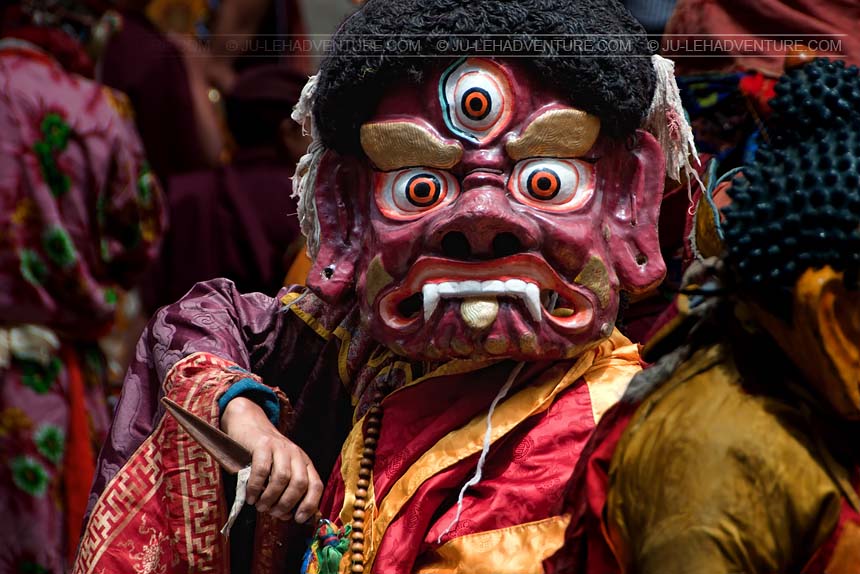Festivals of Ladakh
Celebrated with great fervour every year, the festivals of Ladakh are usually held in the courtyard of Buddhist monasteries. Monks wearing colourful robes and frightful masks perform cham (sacred mask dances). These cham represent the purification of mind and also the triumph of good over evil. The festivals are an important part of Ladakh's cultural life. People, young and old, from all parts of Ladakh attend these monastic festivals.
Festivals are traditionally celebrated to commemorate the birth anniversary of religious figures (Buddha, Padmasambhava, etc.) and other significant dates in the Buddhist calendar.
| Festival name | Location | Year 2025 | Year 2026 |
|---|---|---|---|
| Spituk Gustor | Spituk Monastery | 27-28 Jan | 16-17 Jan |
| Dosmochey | Leh, Diskit, Likir | 26-27 Feb | 15-16 Feb |
| Stok Guru Tsechu | Stok Monastery | 08-09 Mar | 25-26 Feb |
| Matho Nagrang | Matho Monastery | 13-14 Mar | 02-03 Mar |
| Saka Dawa | all over Ladakh | 11 Jun | 31 May |
| Sindhu Darshan | near Shey village | xx-xx Jun | xx-xx Jun |
| Yuru Kabgyat | Lamayuru Monastery | 22-23 Jun | 13-14 Jun |
| Hemis Tsechu | Hemis Monastery | 05-06 Jul | 24-25 Jun |
| Shachukul Kabgyat | Shachukul Monastery | 12-13 Jul | 02-03 Jul |
| Stongde Gustor | Stongde Monastery, Zanskar | 13-14 Jul | 03-04 Jul |
| Phyang Tsedup | Phyang Monastery | 22-23 Jul | 12-13 Jul |
| Karsha Gustor | Karsha Monastery, Zanskar | 22-23 Jul | 12-13 Jul |
| Korzok Gustor | Korzok Monastery | 27-28 Jul | 17-18 Jul |
| Takthok Tsechu | Takthok Monastery | 04-05 Aug | 24-25 Jul |
| Sani Naro Nasjal | Sani Monastery, Zanskar | 08-09 Aug | 28-29 Jul |
| Ladakh Festival | Leh | 21-24 Sep | xx-xx Sep |
| Diskit Gustor | Diskit Monastery | 19-20 Oct | 08-09 Oct |
| Thiksey Gustor | Thiksey Monastery | 08-09 Nov | 28-29 Oct |
| Chemrey Wangchok | Chemrey Monastery | 18-19 Nov | 07-08 Nov |
| Galdan Namchot | all over Ladakh | 14 Dec | 03 Dec |
| Losar (New Year) | all over Ladakh | 20 Dec | 09 Dec |

Spituk Gustor Festival
Spituk Gustor is the first festival celebrated in Ladakh after Losar (the New Year). People brave the chilly weather and attend this festival. The main highlight of the festival is the large thangka of Je Tsongkhapa, the founder of the Gelugpa sect, which is put on display for the public. People also wait in queues at the gate of the gonkhang (main temple) to seek blessings from protector deities such as Mahakala and Sridevi (Palden Lhamo) whose faces are unveiled only during the festival.
Dosmochey Festival
People of Ladakh often look upon Dosmochey as the harbinger of warmer days following months of cold days in the winter. The royal family of Ladakh started Dosmochey as an annual festival. Cham or sacred dances are performed by monks at the old temple below the Leh Palace. Rituals are performed and idols made of dough are either burned or kept in isolation to get rid of evil spirits. Crosses made of threads by the monks are also offered. People adorned in traditional costumes visit the prayer rooms, seeking blessings from the deities and other gods and goddesses. Dosmochey festival is also celebrated on the same day at Diskit gompa in Nubra valley and at Likir gompa.
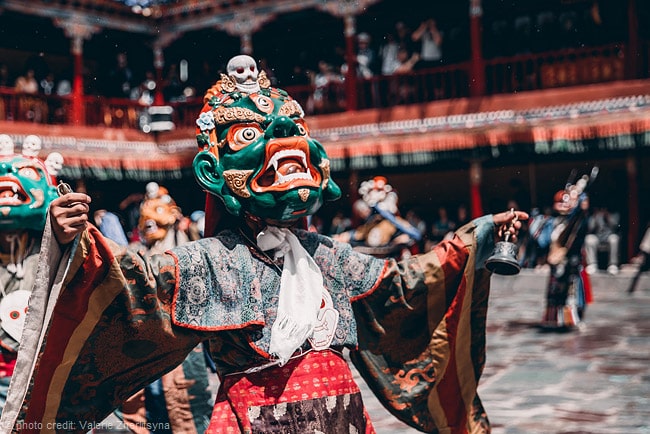
Stok Guru Tsechu Festival
Stok Guru Tsechu festival is held in Stok village which is the present seat of the royal family of Ladakh. This festival is famous for oracles who make predictions for the coming year. These oracles are not monks but laymen who are trained by monks from the Spituk gompa to allow the spirit of the deities to enter their bodies. Before the festival, these laymen are spiritually cleansed and prepared by the monks. People from Ladakh firmly believe in the predictions made by the oracles.
Matho Nagrang Festival
Matho Nagrang festival (along with Stok Guru Tsechu) is well-known as the 'festival of oracles' in Ladakh. Unlike the festival at Stok where deities take over laymen to make predictions, the oracles or ronstang take over the bodies of two chosen monks so that they would make predictions for the village and people of Ladakh. These two monks chosen to be oracles need to meditate for months for the preparation so that they can be ready for the festival and tell the future of the people. Such is the faith of the people of Ladakh that they brave the cold and assemble in large numbers to seek blessings from the oracles and listen to their predictions.
Saka Dawa, Buddha Purnima or Vesak Day
Saka Dawa (also known as Buddha Purnima or Vesak Day) commemorates the birth, enlightenment and death of the Buddha. The people of Ladakh like Buddhists in other parts of the world celebrate Saka Dawa as the supreme festival of all the Buddhists. This festival is usually celebrated in May depending on the lunar calendar. A large number of people from all parts of Ladakh take part in Bhumskor, a procession where people carry sacred religious books along with thangka depicting the life and noble deeds of Buddha. Students, monks and people from all walks of life take part in the procession that culminates at the Polo Ground in Leh. People visit monasteries and seek blessings from Lord Buddha on this day.
Sindhu Darshan Festival
Sindhu Darshan festival is celebrated every year at Shey to pay honour to the river Sindhu (Indus). The Indus river is considered as the birthplace of Indian civilization, the symbol of India’s unity. This three-day festival attracts tourists from all parts of the country. Artists from different parts of India converge to Ladakh and showcase cultural programs such as dance and musical performances at the banks of the Indus river. Tributes are also paid to Indian soldiers who gave their lives in the line of duty. A committee comprising people from different religions hosts a reception ceremony signalling the start of the three-day festival.

Yuru Kabgyat Festival
Lamayuru is one of the picturesque villages in Ladakh and the grandeur of its monastery is further accentuated with the celebration of Yuru Kabgyat festival. Such is the relevance of this two-day festival that monks from different parts of the world attend it in huge numbers. The main highlight of the festival is cham or sacred mask dance-dramas. One of the dances depicts Yama (Lord of death) and Guru Rinpoche or Padmsambhava (also known as the Second Buddha). Sacrificial offerings are made and sacred rites are performed on the concluding day of the festival.
Hemis Tsechu Festival
Hemis Tsechu festival can be considered the most popular monastic festival in Ladakh among the tourists. This festival is held to celebrate the birthday of Padmasambhava (Guru Rinpoche), the founder of Tibetan Buddhism. Sacred mask dances or cham are performed by the resident monks of the monastery in the courtyard. The monastery is home to the world's largest thangka or Tibetan scroll painting. This two-storey-high thangka is unveiled once every 12 years. The thangka was displayed in the year 2016 and it will be shown again in 2028.
Shachukul Kabgyat Festival
Shachukul Kabgyat is the most important festival in Durbuk block as people from different villages from this block gather to celebrate this event. Monks from this block who are studying in different parts of the country make it a habit to attend this two-day festival held at the Shachukul gompa. The monks of this monastery follow the Drikungpa sect, which has other major monasteries at Phyang and Lamayuru.
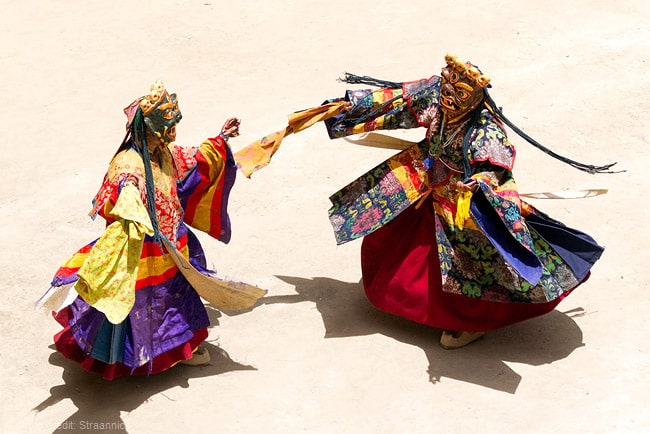
Stongde Gustor Festival
Stongde gompa, one of the oldest monasteries in Zanskar, is famous for the Stongde Gustor festival. People and monks assemble at this monastery that was founded by Lama Marpa, the disciple of Naropa, almost ten centuries back. This festival is celebrated on the 28th and 29th day in the 11th month of the Tibetan lunar calendar. Monks perform sacred mask dances during the festival.
Phyang Tsedup Festival
Phyang Tsedup is one of the most important festivals of Ladakh. The festival is dedicated to Skyoba Jigten Gombo, a saint and the founder of the Drikungpa order. Unlike the sacred mask dance-dramas performed in other monasteries, the cham at Phyang gompa are performed at length and are usually half an hour long. Another attraction of the festival is the thangka of Skyoba Jigten Gombo that is unveiled and put on display every third year (years of the pig, snake and monkey of the Tibetan lunar calendar).
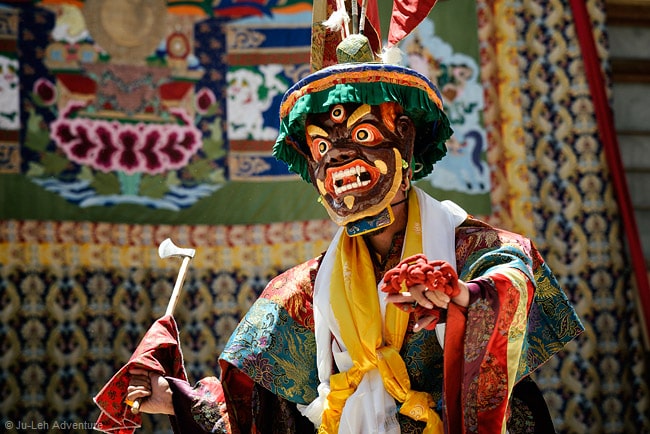
Karsha Gustor Festival
Celebrated at Karsha gompa, the largest monastery in Zanskar, Karsha Gustor signifies the victory of good over evil. Karsha Gustor is celebrated in summer. The main highlight of Karsha Gustor is the future predicted by a layman instead of reputed oracles or soothsayers. This layman is chosen, spiritually cleansed and prepared by the monks of the monastery.
Korzok Gustor Festival
With the Korzok monastery overlooking the majestic Tso Moriri lake, Korzok Gustor festival could easily qualify as one of the most memorable and beautiful festivals in the whole of Ladakh region. What adds charm to the festival is the attendance of Changpa nomadic groups who come in large numbers to attend the festival. Korzok monastery, affiliated to the Drukpa lineage, was founded by Kunga Lodro Ningpo around three centuries back.

Takthok Tsechu Festival
Takthok (or “rock roof” in Ladakhi as the roof and walls are made of rock) gompa is the lone Nyingmapa (the oldest of the four major schools of Tibetan Buddhism) monastery in Ladakh. The monastery is built around a cave believed to have been used by Guru Rinpoche for meditation in the eighth century. This monastery that houses around 60 monks suddenly comes alive at the time of Takthok Tsechu festival to celebrate an auspicious day commemorating Guru Rinpoche. Takthok Tsechu (the 10th day of the Tibetan lunar calendar) is celebrated in summer. Cham or sacred mask dances are performed depicting the early journeys of Guru Rinpoche.
Sani Naro Nasjal Festival
The establishment of Sani monastery dates back to the times of Kanishka Empire in 1st Century CE. Therefore, Sani is the oldest monastery in the region of Ladakh and Zanskar valley. Presently it belongs to Drugpa Kagyu, a sub-lineage within the Kargyu School. The monastery hosts its annual festival, Sani Naro Nasjal, between 15th and 20th of the sixth Tibetan month. The monks from Bardan monastery perform at Sani. On the occasion, the statue of famed Yogi, Naropa, is unveiled for the locals and pilgrims to receive blessings. Interestingly, of many monastic festivals, only Sani hosts dances from the newlywed brides of the village. On the culmination of celebrations, the villagers greet, congratulate and wish the newlyweds with auspicious khataks (traditional ceremonial scarves). You could also witness the blossoming of the Guru Naropa flower and the historical Kanishka Stupa behind the Sani Monastery.
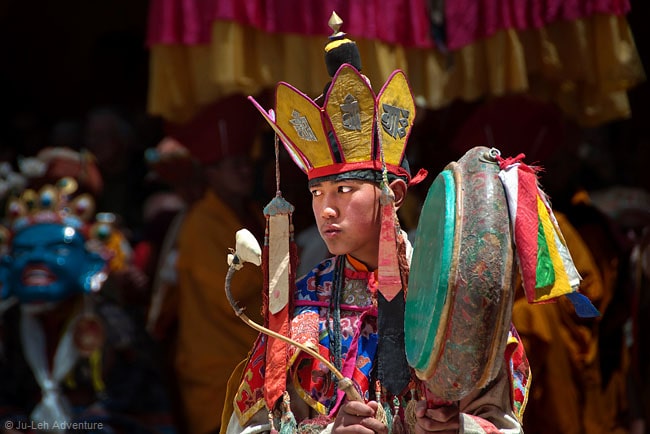
Ladakh Festival
Ladakh Festival, organised by the Tourism Department with the help of the locals, aims to promote tourism and the rich culture of the region. This festival organised in September attracts thousands of tourists from across the globe. Various cultural programs are held such as folk dances, traditional music, Ladakhi food, handicraft products, archery competitions and polo matches. Mask dances are one of the highlights of the festival. This festival is a perfect opportunity for the tourists to discover the culture and lifestyle of the Ladakhi people.
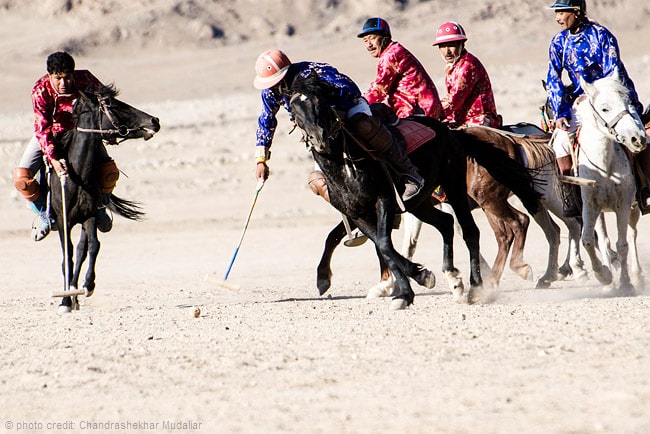
Diskit Gustor Festival
The residents of Diskit, the headquarter of Nubra valley, celebrates Diskit Gustor festival in October. Since it is one of the biggest festivals in the entire Nubra valley, people from almost every village take part in it in huge numbers. Like other festivals in Ladakh, Diskit Gustor festival also marks the victory of good over evil as the effigy of the evil (called Storma in Ladakhi) is burned. Cham are performed by the monks of Diskit gompa during the two-day festival.
Thiksey Gustor Festival
Celebrated in either October or November, Thiksey Gustor along with Chemrey Wangchok is one of the last festivals celebrated before Ladakhi New Year or Losar. The festival at Thiksey monastery is as majestic as the structure itself and attracts many tourists during the two-day event. People brave the cold to attend the early morning prayers performed by the monks of the monastery. One of the highlights of the festival is the mask dances performed by the monks wearing black hats, who distribute the sacrificial cake (known as Storma) at the end to signal the victory of good over evil.
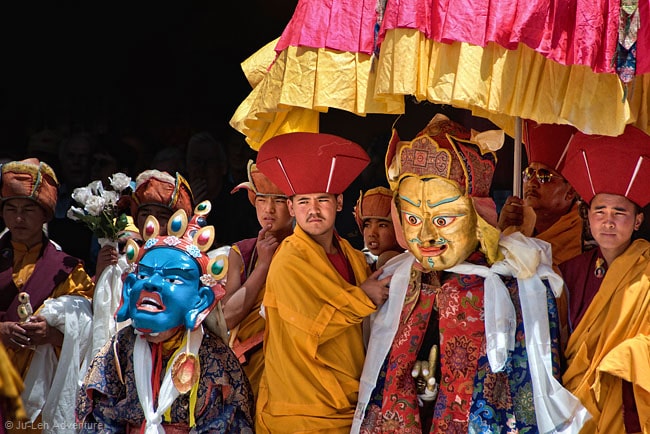
Chemrey Wangchok Festival
Chemrey gompa, perched on a hill, remains one of the most picturesque monasteries in Ladakh. As much as it is known about the monastery, not many are aware of the festival known as Chemrey Wangchok that takes place at this 15th-century monastery. This festival is celebrated on the 28th and 29th day of the ninth month of the Tibetan lunar calendar. Monks from the Drukpa lineage meditate for a week and then perform cham on both the days of the festival.
Galdan Namchot Festival
Galdan Namchot festival marks the beginning of the New Year celebrations in Ladakh. This festival is celebrated to commemorate the birthday and Buddhahood of Je Tsongkhapa, who was a Tibetan scholar and founder of the Gelugpa sect. All the monasteries, public buildings and houses are lit up during Galdan Namchot. People prepare and kindle butter lamps to signify the victory of light over darkness. They prepare mouth-watering delicacies during the festival and visit their relatives or near and dear ones to eat with them.
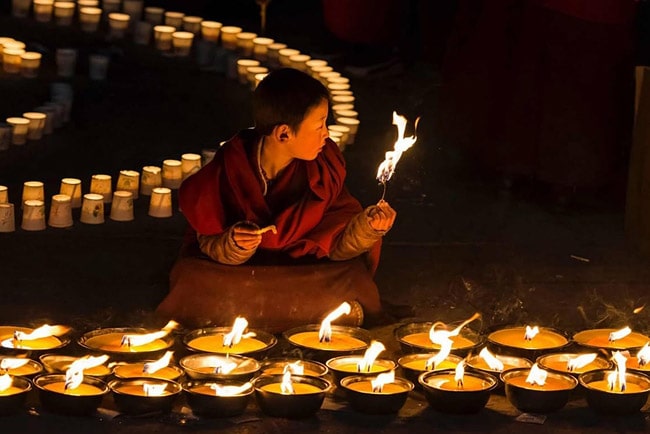
Losar Festival (Ladakhi New Year)
Losar festival or the Ladakhi New Year is one of the most awaited festivals of Ladakh. During this two-week-long festival, people visit their relatives and friends. The first three days are considered the most important ones when people also visit monasteries to make offerings and seek blessings. Ladakhis from all religions celebrate this festival with full fervour.

 Hemis to Tso Moriri
Hemis to Tso Moriri

